
Click image for larger version only
Map
(from 1940)
I would like to say that the adjacent picture is of 82 Victoria Road, Charlton but on two counts it isn’t. Victoria Road was renamed Victoria Way in the 1930s or earlier (Olive Knight said her mother took her back there to visit an old neighbour after returning from Burma and it was renamed then) and numbers 80 and higher were demolished to make way for some rather shabby looking council houses which look as though they may date from the 1950s. Perhaps there had been bomb damage during the war. The house shown here is No. 78. However as all the houses on that side of the road are of the design shown there is no reason to suppose that No. 82 was any different.
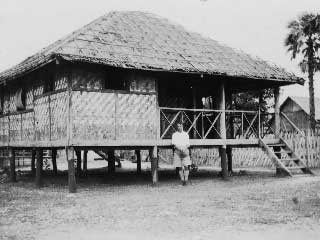

Click image for larger version only
Map
(from 1940)
This house remained a Barker family home for many years afterwards; I remember visiting it myself once and being impressed, as a young lad, by the fact that it had gas mantles instead of electric light and a railway line ran down the road outside.

Photograph of Ripley Rd. not yet available
Photographs from this era
Map
(from 1940)
After the outbreak of war in 1939 they found themselves a little too near the docks for comfort and in 1940 a bombing raid badly damaged the house while the family were hiding in the garden shelter. Gladys decided to walk to her brother Walter’s house in Howard’s Road, Plaistow with nothing but a few clothes in a suitcase and Leslie clutching his precious wireless set. They had progressed only a few streets when they encountered Walter and his family making their way in the opposite direction with a similar idea in mind, his own house having been totally destroyed by a bomb on the very same night.
Whilst wondering what to do the air-raid siren went off again and they sheltered in a nearby church. From there they went to the Hotten’s house in York Road, Leyton (Leslie by then being engaged to Vera Hotten) and there they stayed for a couple of days. During that time Gladys, Leslie and Olive went back to Ripley Road to inspect the damage and although some parts of it were still smouldering, decided that other parts could be made habitable; so they returned to Leyton overnight to make plans to move back. The following morning after calling into Ripley Road they went out to buy essentials and materials for repairs. While out at local shops three bombs fell nearby with no siren having been sounded. When they arrived back at the house they found that one of those bombs had blown their house away completely.
This family disaster led both Gladys and brother Walter’s families to share accommodation in Boston Manor, near Ealing, West London, Walter’s daughter Iris found it through a friend at her work at a jeweller’s shop in central London.

Towards the end of 1941 Gladys and Olive found a house to rent in East Ham which they subsequently bought and which Olive still owns. Leslie joined the RAF at the same time and also left Elthorne Park Road but Walter, his wife Winnie and daughter Iris continued to live there and bought it when the opportunity arose. Iris was still in residence when she died in 2005 and it may have remained in the family even longer had her son Christopher not been threatened by Richmond council with its confiscation if he continued to leave it unoccupied. It would seem that the Nazis drove the family to find shelter there and the latter-day Nazis that control this country drove them out.
Leslie Knight married in 1942 and whilst he was stationed in Bedfordshire his new wife Vera continued to live with her family in Leyton.
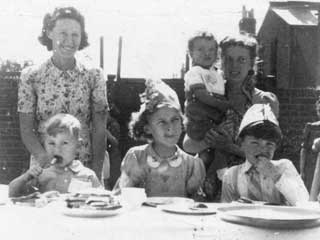
Vera Knight holds her 19 month old
son
In the garden
Map
(from 1940)
During those raids Grandad stayed in the house so that the rest of the family could all get into the shelter so it was particularly lucky that one day, mother and I, got an invitation to take a break in Potton. Off we went to the comparative safety of Bedfordshire and that night Grandad was able to shelter when the siren went off. Just as well; the house next door received a direct hit by a V1, killing the occupants and destroying their house and severely damaging ours. Mother lost most of her wedding presents in that raid and many family artefacts, photographs etc. One or two of her chipped dinner plates do however still survive to this day. Apart from the VE Day Party photographs there is a small number of pictures of the Hotten family taken at 6 York Road, Leyton before it was bombed in 1944.
I believe everyone moved briefly to nearby Ruckholt Road in 1945 as that address was often spoken of by older family members, however the only evidence for it that now exists is my own Identity Card which is for 37 Ruckholt Road, E10. and date stamped 13 August 1945. However as the same date is shown against 126 Whipps Cross one can only guess that this the date of leaving Ruckholt Road. If the Doodlebug destruction of York Road caused all the Hottens and Knights to move to Ruckholt Road it would have been more than a little overcrowded and may explain why the Hottens are listed in the telephone directory of 1946 as being at 4 Brooke Court, Harrow Green, Leytonstone (LEYtonstone 3874), an address I vaguely remember visiting. The Knights later moved to the Nissen hut at Whipps Cross. The Hottens had moved to 37 Fourth Avenue, Porter’s Field by 1949.
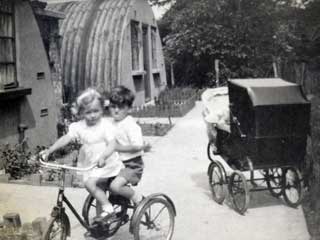
Malcolm on three borrowed wheels,
Rosemary on four of her own
Map
(from 1940)
The family moved there after losing a house in York Road, Leyton during a flying bomb attack in 1944. A street party was held there to celebrate V.J. Day in August 1945. During the severe Winter of 1947 the water pipes buried deep in the ground froze solid and tankers delivered emergency supplies which had to be collected in zinc plated baths and buckets. Not ideal circumstances for the birth of a new baby.
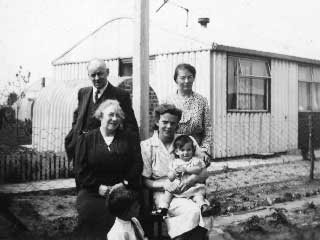
Walter Barker, his sister
Gladys and wife Winnie with
Vera Knight and her children
Rosemary and
Malcolm
Map
(from 1959)
Opposite the estate was what we called the water works although the map suggests it was a sewage works. No wonder we were constantly warned to keep away from drains for fear of contracting diphtheria or scarlet fever. The gas works, or the Gas, Light and Coke Company as I think it was called was conveniently within pram wheeling distance to get it filled with coke to feed the kitchen boiler.
Whilst his wife and children remained at Porter’s Field Leslie Knight began work on his career working on jet engine development with Frank Whittle in Whetstone, Leicestershire and at N.G.T.E. at Pyestock, Hampshire. His weekday addresses (as registered on his Identity Card) were 9 New Walk, Leicester and ‘Thark’. Frimley Green Road, Frimley, Aldershot, Hants respectively.
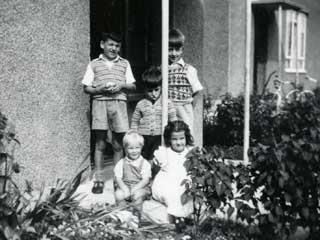
Malcolm and
Rosemary Knight and a young neighbour, Christopher Craig, with
Ken Coleman’s two nephews,
Terry and
Trevor
Photos of Minley Estate
Maps
(from 1947 and 1959)
The area was thickly wooded which provided a ready made playground augmented by cricket and football in the road outside, traffic being almost totally absent.
A single nearby shop (Malekin’s) delivered most of the groceries and in the school holidays I earned 2/- a day by helping Mr. Malekin pack them and sometimes accompany him in his Morris van. Occasionally he would take me out for a drive in his Vauxhall Cresta. Vegetables and fruit were provided by a greengrocer (Mr. Drew) who sold them from the back of his van but who also had a shop by the side of the railway bridge at the junction of West Heath, Minley and Fleet Roads.
Dad cycled each day to his work at N.G.T.E. and came home for lunch and on a couple of evenings a week cycled to Farnborough Grammar School where he was continuing his studies and which I attended from 1954 to 1961. Most people locally worked at the Royal Aircraft Establishment and high speed flight, and the occasional crash, were part of the regular scene. Spitfires in the early days, then Meteors and Canberras setting speed and altitude records and Supermarine Swifts and Hawker Hunters diving through the sound barrier right overhead. Even Vulcan bombers rolling at low level; all with no apparent regard for public safety. Development aircraft such as the Flying Wing, the Flying Bedstead and the Rotodyne were also seen as well as early versions of production aircraft such as the English Electric P1, later to be called the Lightning and Hawker P1127 (Harrier).
In 1950 we acquired a television set (a 12" Philips which I believe cost 110 guineas including aerial installation), the second in the street which proved very popular for the Coronation in 1953. A year later a pre-war (1936) Austin 12 car was purchased for £75, to be replaced later by a very similar (1937) Austin 18 (EMT 931) for £125. This was eventually exchanged for a 1953 Ford Anglia (NLJ 514) which may have been newer but was a rattling tin box. All of them provided many trips into the country and to the coast when motoring could be regarded as a pleasure activity. Petrol was 4/9d a gallon (5 pence per litre in today’s money).
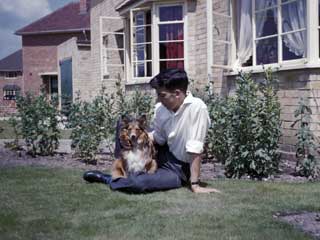
Malcolm
with the family dog, Judy.
Old black & white photos
Map
(from 1959)
The move from Farnborough meant that Malcolm had to take the No.9 bus to school, changing buses at Aldershot, and his father, Leslie, was no longer within easy cycling distance of work at the N.G.T.E.. Rosemary however was able to go to a local school. Just before the move to Church Crookham she also decided that she’d like a dog and so Judy became a big part of our lives demanding walks (along the Basingstoke Canal and occasionally falling in being a favourite) and managing to get her face into a high proportion of the photographs taken over the next 15 years.
It was a busy period at N.G.T.E. with Concorde engine testing in full swing so Leslie often worked late into the night running his noisy engine test facility. In 1961 Malcolm left school and found a job at Prudential Assurance in Holborn; his first quarterly season ticket, including the Underground from Waterloo, cost £19. At the end of 1962 he decided that life insurance and pensions were not for him and (with a good deal of prompting from his father) obtained a job with the G.P.O. in a London telephone exchange; AVEnue in terms of the old numbering scheme. At around the same time Rosemary also went to work at N.G.T.E. in a secretarial capacity.
The garden had not long been transformed from its desert state, the topsoil having been almost pure sand, when Leslie and Vera Knight decided their future would be better served by moving from a house tied to a job and buy one of their own..

Malcolm with
Anne
Map
(Same map as for Johnson Way, description varies)
It was within two miles of Leslie’s and Rosemary’s work at N.G.T.E. and a mile from Fleet station from which Malcolm took the steam train to London every day until 1965 when he married Anne McGregor who he had met at work and moved to his own flat at 3 Legge Crescent, Aldershot.
Despite his fortnightly commute to Toulouse as part of the Concorde development project Leslie found time to transform the rear garden into a colourful flower garden and produce a wide variety of vegetables and soft fruit.
In 1969, after his work on Concorde finished Leslie too began to commute to London by train. Malcolm moved back to Fleet having bought a new house for £5,600 at 67 Connaught Road.
The bungalow was eventually sold for £16,000.
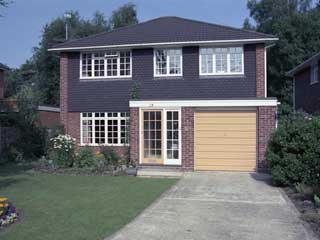
Map
(Same map as for Aldershot Road, description varies)
From this address Rosemary was married in 1975 and later the same year Malcolm and his family moved in for three weeks having been forced to sell 67 Connaught Road earlier than planned and the house at 20 Albany Road still not being completely finished. he eventually moved into the new house on 7th December 1975 which is just as well as his builder went bankrupt the following day causing others less fortunate buying similar houses in Albany Road to spend more than six months in temporary accommodation while the problems were sorted out.
Leslie Knight retired from work on his 60th birthday in 1979 and went on his first foreign holiday with Vera but it was not a success - the hotel was only part built - and soon after returning became very ill. It took 18 months to diagnose coeliac disease which is simple to treat once recognised but can be fatal if not and so Les’s health took a severe blow. Once recovery was under way thoughts began to turn to a seaside retirement home.
It took best part of a year to sell the house and it eventually sold for £54,000.
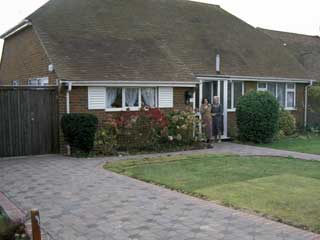
Immediately after moving in Les decided that the suspended polished wood floor was creaking too much and had too many gaps in it so took it all up and reinstalled it and then had the bathroom completely refurbished at a cost of £581.15 for the component parts and £653.38 to have a local builder fit it. The latter included work on the sewer pipes and a new inspection chamber in the front garden. A conservatory for the rear garden followed at a cost of £1,890.
Vera who had always been a member of church affiliated Mother’s Union and Young Wives groups at addresses from Twelve Acre onwards joined both in Rustington and was soon elected to their committees. Les became an active member of the local bowls club and renewed his interest in painting in oils.
In the Autumn of 1985 Les developed a cough and died of lung cancer only six months later at the age of 68. Vera died in the local St. Barnabas hospice in 1998 aged 77.